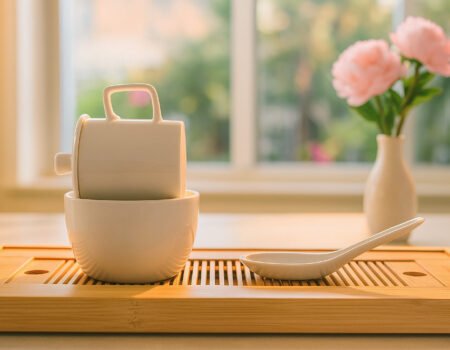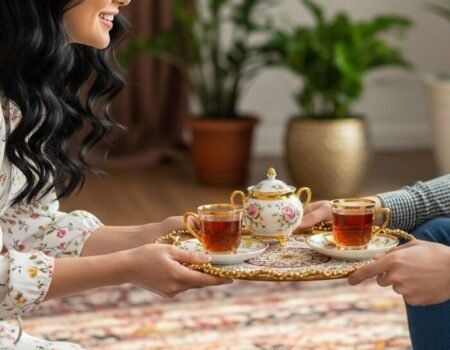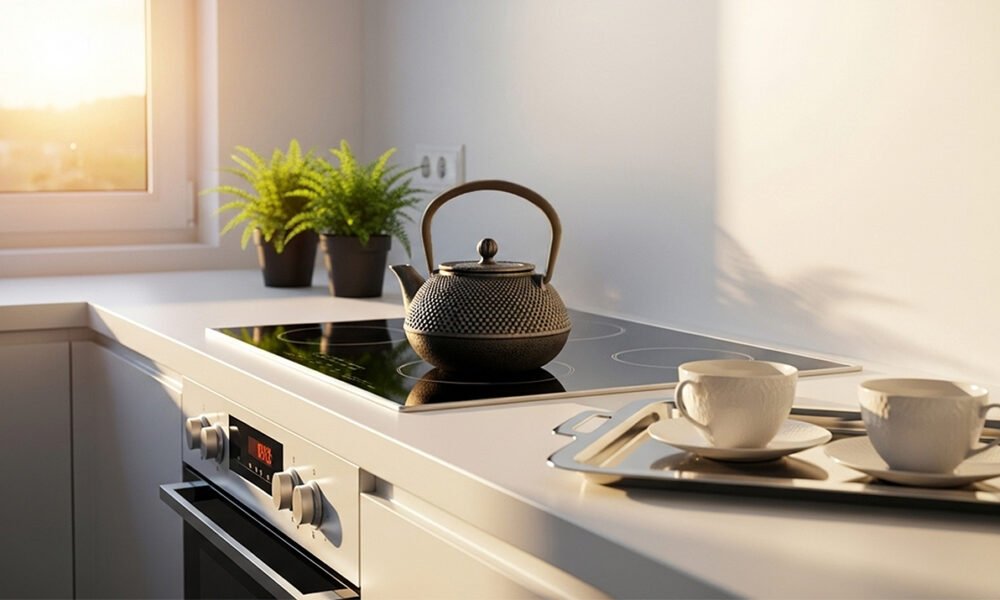
Cast Iron Teaware for Superior Heat Retention
Index
Index
Does your tea get cold too quickly in regular teapots? Cast iron teaware keeps your tea hot longer than any other teapot. This guide explains the types of cast iron teapots, their best uses, and how to care for them properly.
Learn why tea lovers choose these durable pots for better brewing.
Key Takeaways
- Cast iron teapots come in two main types: tetsubin (unglazed) and tetsu kyusu (enamel-coated), each offering unique brewing benefits.
- Unglazed tetsubins add minerals to water and work best with robust teas like black tea and pu-erh, while enameled pots preserve delicate tea flavors.
- These teapots keep tea hot for up to an hour after brewing due to their dense metal construction that distributes heat evenly.
- Never use soap on unglazed cast iron teaware, and avoid brewing delicate green and white teas in cast iron as the high heat ruins their subtle flavors.
- Proper drying after each use prevents rust formation, helping your teapot last for decades or even generations with the right care.
Understanding Cast Iron Teaware
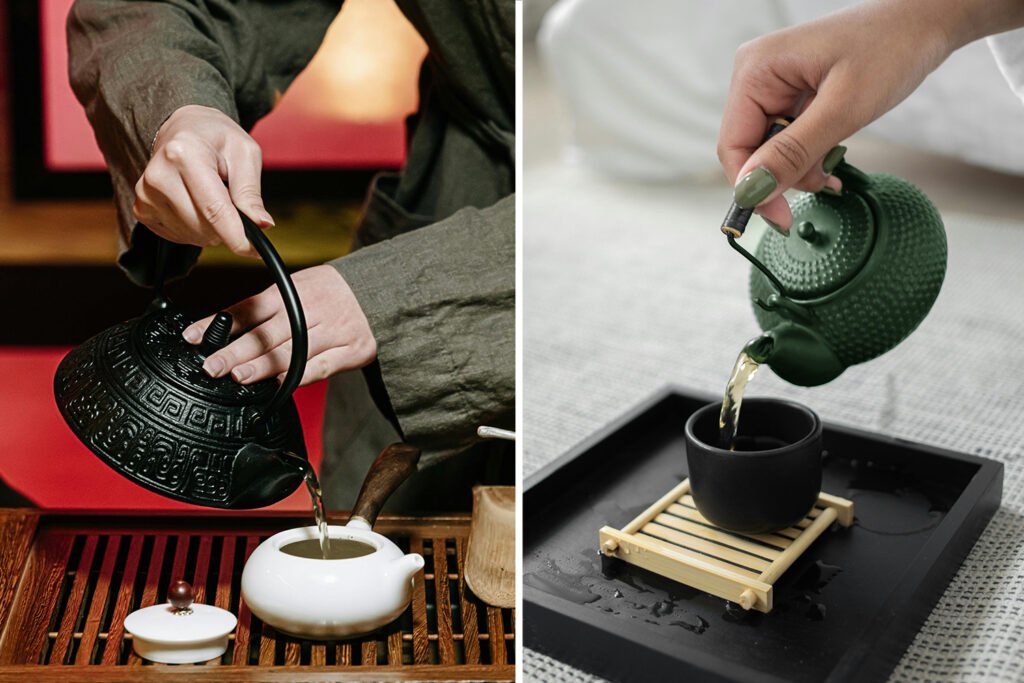
Cast iron teaware brings unique qualities to your tea brewing experience. These traditional vessels offer both practical benefits and deep cultural connections to tea traditions.
Key Types: Tetsubin and Tetsu Kyusu
Cast iron teaware comes in two main types: tetsubin and tetsu kyusu. Tetsubin pots feature unglazed interiors that interact with water, adding minerals and subtle iron notes to your brew.
These traditional Japanese kettles excel at boiling water and maintaining high temperatures for extended periods.
Tetsu kyusu teapots have enamel-coated interiors that prevent direct contact between tea and iron. This design preserves the pure flavor of delicate teas without metallic influence.
The glazed interior makes these pots more versatile for brewing different tea varieties while still offering excellent heat retention properties that cast iron is famous for.
General Properties: Heat Retention and Durability
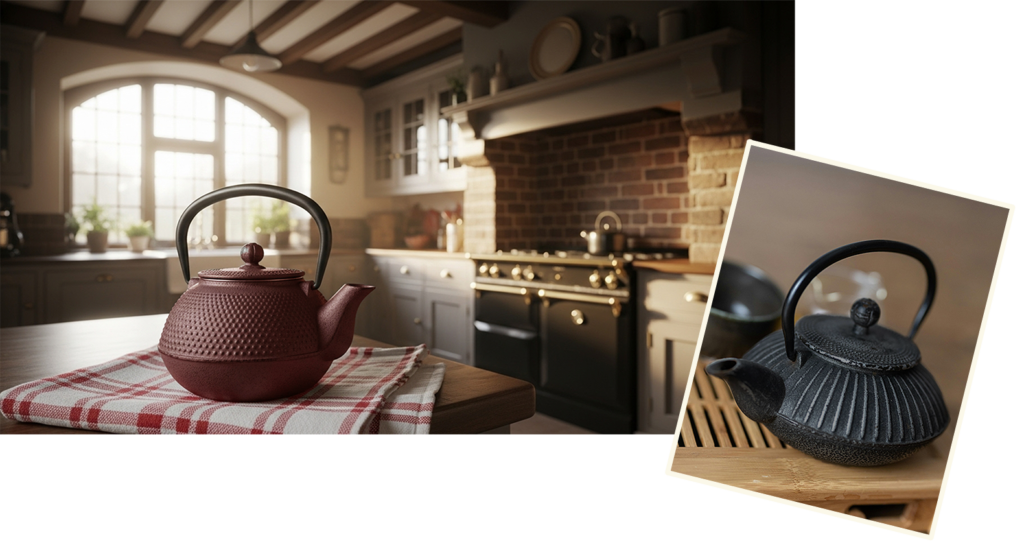
Cast iron teaware stands out for its amazing heat retention abilities. The dense metal holds warmth much longer than glass, ceramic, or porcelain options. This superior heat retention keeps your tea at the perfect drinking temperature throughout your entire tea session.
Tea lovers appreciate how the steady heat helps extract flavors evenly and creates a more satisfying drinking experience. The thick walls distribute heat uniformly, which means no sudden temperature drops that can affect your tea’s taste.
Durability remains another key benefit of cast iron teapots and kettles. These pieces often last for decades or even generations with proper care. The sturdy construction resists chips, cracks, and breaks that plague more fragile teaware.
Many tea enthusiasts consider cast iron a worthy investment because of this longevity. A quality cast iron teapot might cost more initially but provides value through years of reliable service.
Next, we’ll explore the specific characteristics of unglazed cast iron teaware known as Tetsubin.
Unglazed Cast Iron (Tetsubin)
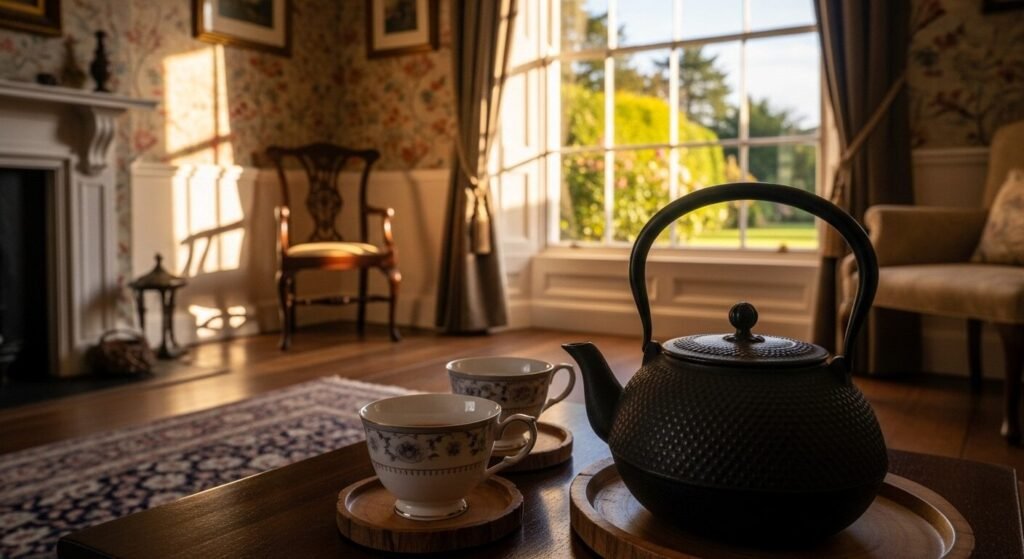
Unglazed cast iron teapots (Tetsubin) transfer iron into your water, adding a mineral richness to your brews. These traditional Japanese kettles create a smooth, round mouthfeel that many tea lovers prize for certain teas.
Characteristics and Water Interaction
Unglazed cast iron teapots, known as tetsubins, interact directly with water to create unique flavor profiles. The iron surface releases small amounts of iron into the water, slightly altering taste and adding mineral content.
This interaction softens water and reduces chlorine taste, making tea brewed in tetsubins smoother and more rounded. Many tea experts prize this quality for enhancing certain teas, especially robust varieties like pu-erh and black tea.
Iron’s natural properties also help purify water through a mild oxidation process. The metal surface traps impurities and neutralizes some chemicals found in tap water. This purification effect builds over time as the teapot develops a natural patina from regular use.
Tea enthusiasts often notice this improvement in water quality translates directly to better-tasting tea with more complex flavor notes.
Primary Uses and Taste Considerations
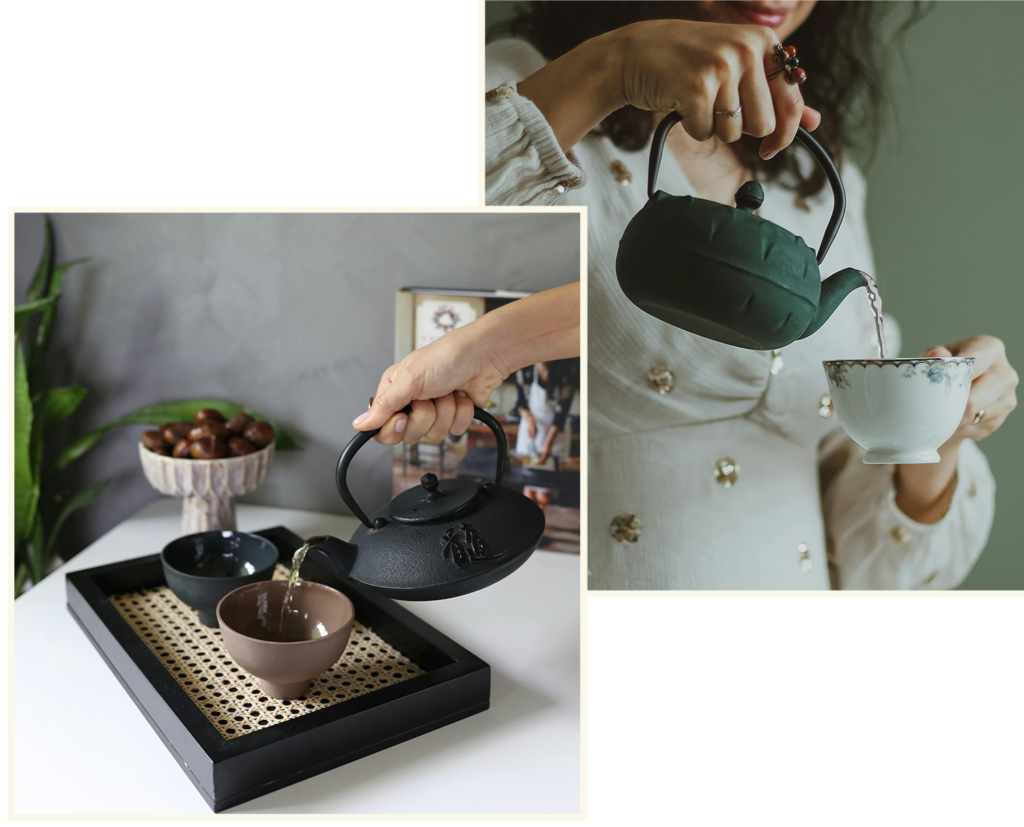
The mineral interaction in unglazed tetsubins creates an ideal vessel for brewing certain teas. These pots excel with robust teas like black tea, pu-erh, and herbal blends that benefit from steady heat.
Tea lovers prize tetsubins for their ability to round out flavors and add subtle mineral notes that enhance depth and complexity. Many tea experts note that water boiled in a well-seasoned tetsubin tastes smoother and more refined.
Cast iron teapots bring out different qualities in various teas through their heat retention properties. The steady temperature helps extract full flavors without the harsh notes that can come from uneven brewing.
For delicate green teas, use water that has cooled slightly before pouring into your tetsubin to prevent scorching the leaves. The iron pot will maintain this perfect temperature throughout your tea session, allowing multiple steepings from the same leaves.
Enameled Cast Iron (Tetsu Kyusu)
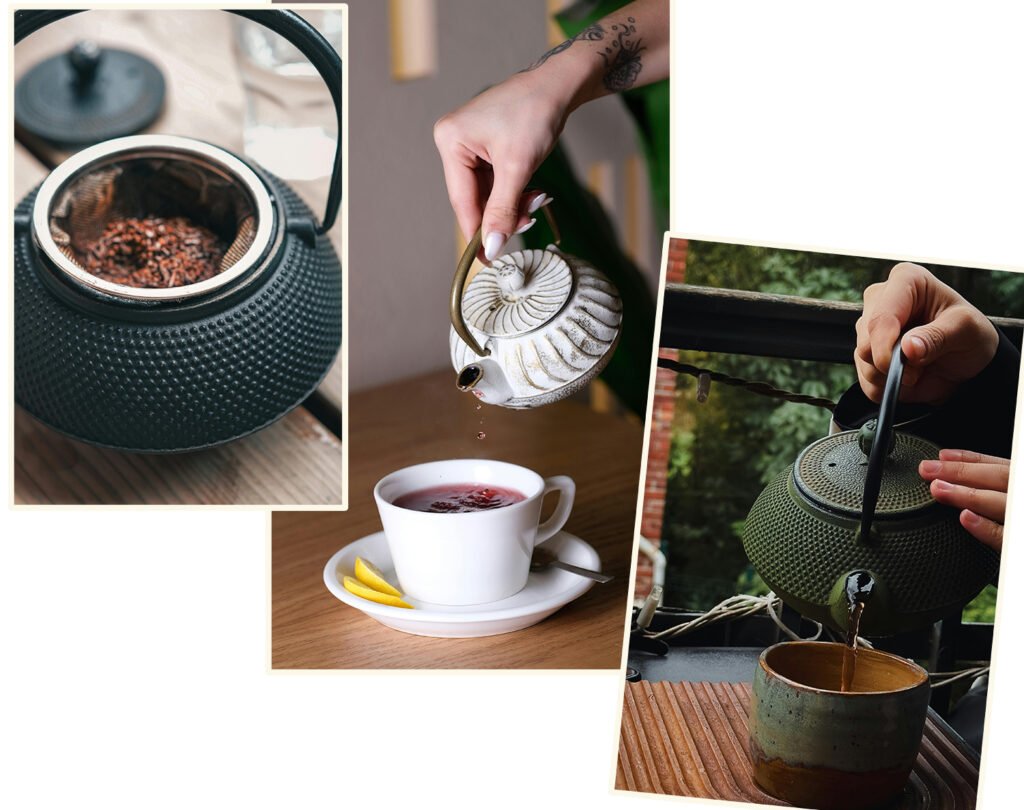
Enameled cast iron teapots offer modern tea lovers protection against rust while maintaining excellent heat retention. These Tetsu Kyusu vessels feature a glass-like interior coating that prevents metal interaction with your tea.
Characteristics and Flavor Neutrality
Enameled cast iron teapots feature a glass-like interior coating that creates a neutral brewing environment. This special coating prevents the iron from directly contacting your tea, maintaining each tea’s true flavor profile without adding metallic notes.
The enamel layer acts as a barrier that stops chemical reactions between the iron and tea compounds. Tea enthusiasts appreciate this quality when brewing delicate white teas or complex oolongs that demand flavor purity.
The smooth interior surface also makes these teapots easier to clean than their unglazed counterparts, as tea residues cannot penetrate the non-porous enamel coating.
Usage Limitations and Enamel Care
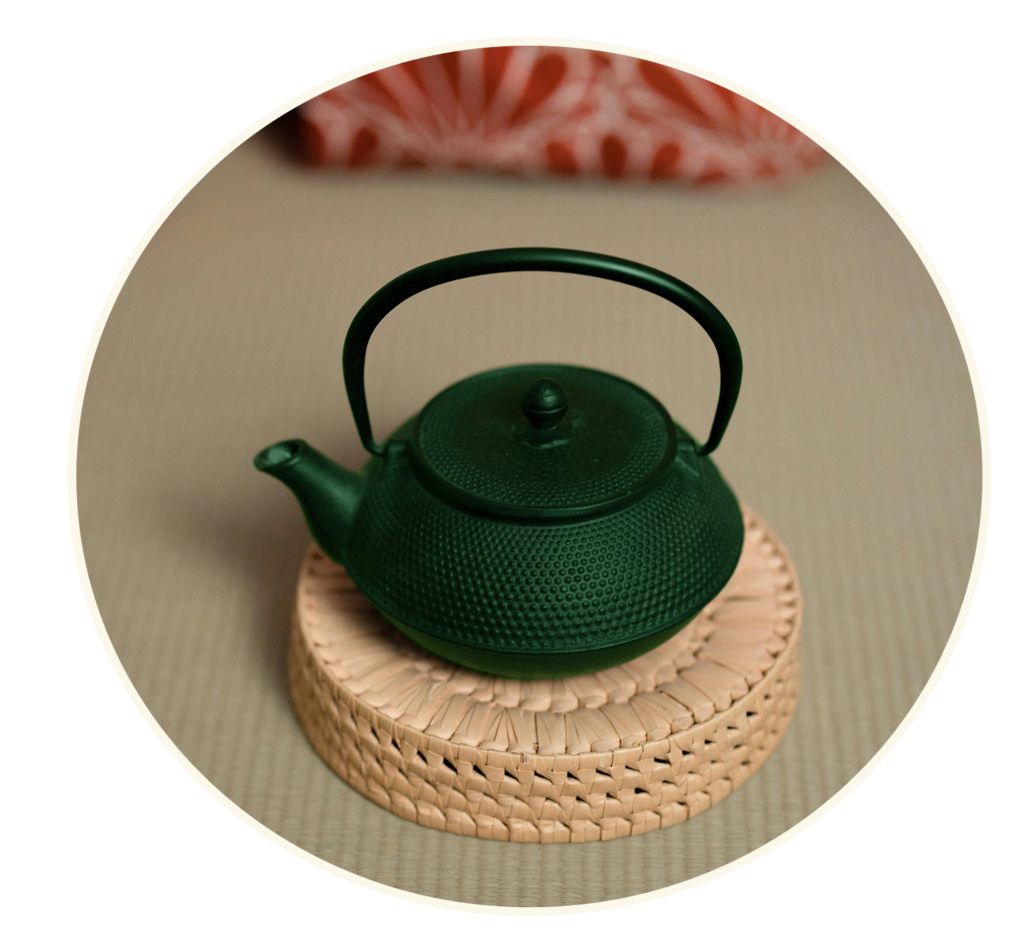
Enameled cast iron teaware offers beauty and durability but comes with specific usage limits. Proper care extends the life of your teapot and keeps it brewing perfect cups for years.
Heat and Temperature Safety
- Heat exposure must stay moderate with enameled teapots to prevent damage to the glaze coating.
- Direct flame contact can crack or chip the enamel, so use low heat sources only.
- Thermal shock poses a real threat, so avoid putting a cold teapot on hot surfaces.
Cleaning and Maintenance
- Dishwashers harm enamel over time, making hand washing the safer option for longevity.
- Harsh scrubbing tools scratch the surface, so stick with soft sponges for cleaning.
- Metal utensils can chip the enamel, so use wooden or silicone tools when needed.
- Acidic cleaners eat away at enamel coatings, making mild soap a better choice.
- Stubborn stains need gentle treatment with baking soda paste rather than abrasive cleaners.
Storage and Long-term Care
- Drying thoroughly after each use stops moisture from causing rust on any exposed iron.
- Storage requires careful stacking to avoid chips and cracks in the enamel finish.
- Lid placement matters during storage – rest it separately or loosely on the pot to prevent sticking.
- Tea types with strong tannins may stain light-colored enamel over time despite proper care.
Suitability for Different Tea Types
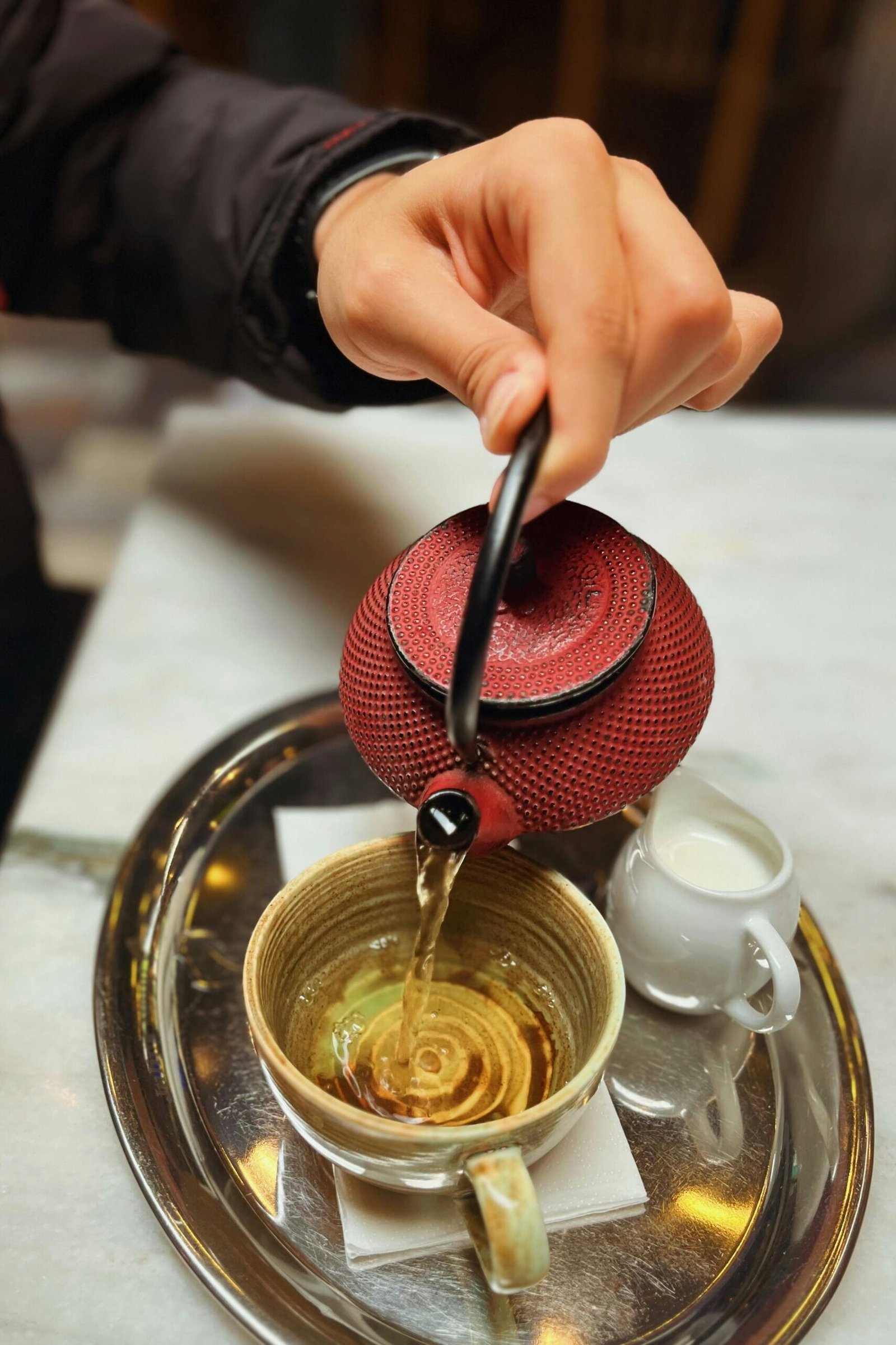
Cast iron teaware works better with some teas than others. Your teapot choice directly affects flavor, brewing time, and tea experience.
Ideal Teas for Cast Iron
Cast iron teaware enhances certain tea varieties through its excellent heat retention properties. The right tea choice maximizes your cast iron pot’s benefits and delivers a superior brewing experience.
Strong and Dark Teas
- Black teas thrive in cast iron pots because they require high temperatures (200-212°F / 95-100°C) for proper extraction of flavors and tannins.
- Pu-erh teas benefit greatly from cast iron brewing as their complex earthy notes develop fully with steady, high heat.
- Dark roasted teas generally pair well with cast iron brewing because their robust flavors stand up to the pot’s mineral influence.
- Aged teas often show improved character when brewed in cast iron, as the consistent heat helps unlock their mature, developed flavors.
Temperature-Sensitive Teas
- Oolong teas perform exceptionally well in cast iron teapots since their partial oxidation requires consistent temperatures to release their unique floral and fruity characteristics.
- Herbal infusions like rooibos and chamomile gain depth and richness when brewed in cast iron, which maintains ideal steeping temperatures throughout the process.
Spiced Tea Blends
- Chai blends with spices such as cinnamon, cardamom, and cloves extract more fully in cast iron’s sustained heat, creating more flavorful results.
- Masala tea mixtures benefit from cast iron’s ability to maintain high temperatures needed for proper spice extraction.
Now let’s examine which teas you should avoid using with your cast iron teaware to protect both your equipment and tea quality.
Teas to Avoid with Cast Iron
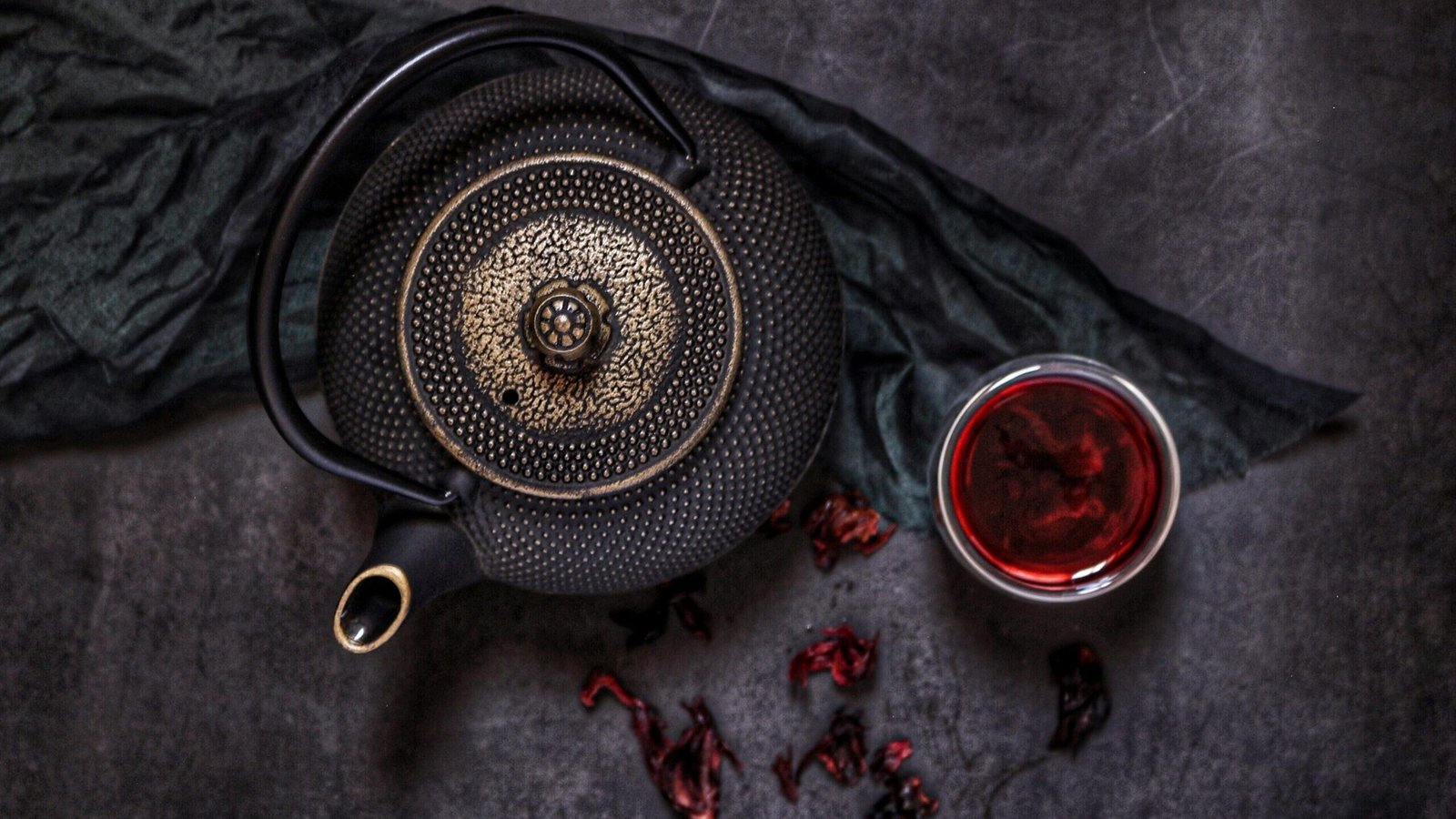
Cast iron teapots work well with many teas but not all varieties. Some teas can damage your teaware or lose their unique qualities when brewed in cast iron vessels.
Delicate Teas That Overcook
- Delicate white teas suffer in cast iron pots because the high heat retention can overcook their subtle flavors. These teas need lower temperatures to preserve their light, sweet notes.
- Green teas often taste bitter when brewed in cast iron because these pots maintain heat too strongly. The extended high temperature exposure ruins the fresh, grassy profile of quality green teas.
- Yellow teas lose their distinctive character in cast iron teapots. The intense heat masks the mild, slightly sweet taste that makes yellow teas special.
Teas That Can Damage Cast Iron
- Highly acidic fruit teas can react with unglazed cast iron surfaces. This reaction might damage your teapot over time and alter the tea’s flavor profile.
- Herbal infusions containing citrus oils may cause damage to enameled cast iron surfaces. The oils can gradually break down the protective enamel coating.
Specialty Teas That Lose Their Value
- Very rare or expensive teas waste their unique qualities in cast iron. The strong heat retention often overwhelms the subtle flavor notes that make premium teas worth their cost.
- Oolong teas with delicate floral notes get muted in cast iron brewing. The high heat masks the complex flavor transitions that make good oolongs special.
- Teas requiring precise temperature control should avoid cast iron vessels. The excellent heat retention makes it hard to maintain exact brewing temperatures needed for some specialty teas.
Now let’s explore the essential care and maintenance practices that will keep your cast iron teaware in perfect condition for years to come.
Essential Care and Maintenance for Cast Iron Teaware
Proper care keeps your cast iron teaware in top shape for many years. You need simple tools and regular habits to protect these durable pieces from damage.
Cleaning Procedures
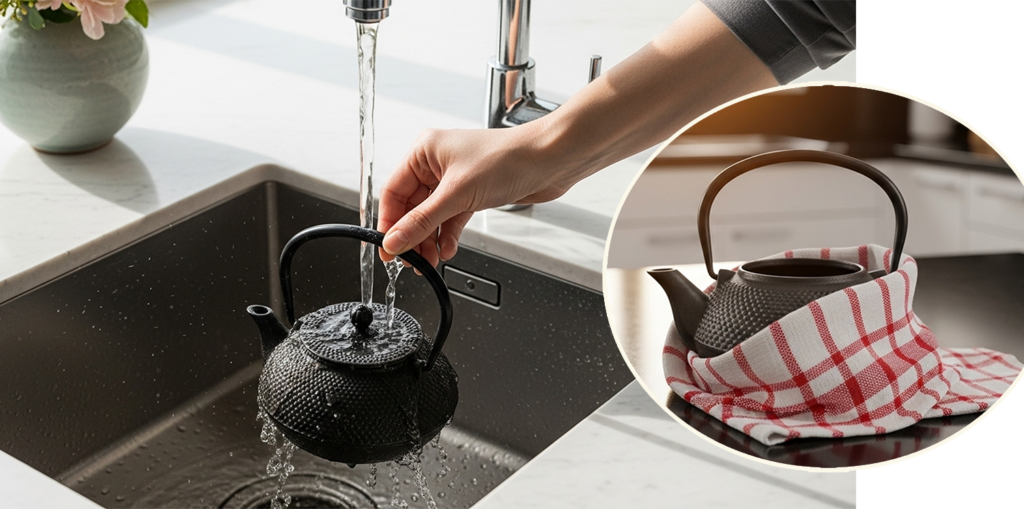
Cast iron teaware needs specific cleaning methods to maintain its quality and longevity. Proper care prevents rust and keeps your tetsubin or tetsu kyusu in prime condition for years of tea brewing.
Daily Cleaning Steps
- Rinse your cast iron teapot with hot water only – never use soap or detergents.
- Wipe the exterior with a soft cloth to remove water spots after each use.
- Use a soft brush to gently scrub away any tea residue from the interior.
- For stubborn stains, fill the pot with boiling water and let it sit for 10 minutes.
- Avoid abrasive scrubbers that might damage the surface or enamel coating.
- Clean the spout thoroughly by running hot water through it several times.
- Remove the lid and clean it separately to prevent moisture buildup.
- For enameled cast iron, check for cracks in the coating during cleaning.
Drying and Storage
- Empty all water from the pot after cleaning to prevent rust formation.
- Allow your teapot to air dry completely before storing it away.
- Place the lid slightly ajar during storage to allow air circulation.
- Apply a thin layer of tea oil to unglazed cast iron surfaces if storing for extended periods.
Important Usage Note: Always use medium to low heat rather than high heat, especially on induction stoves, because intense or rapid heating can cause the cast iron to become brittle, crack, or deform over time
Drying and Storage Best Practices
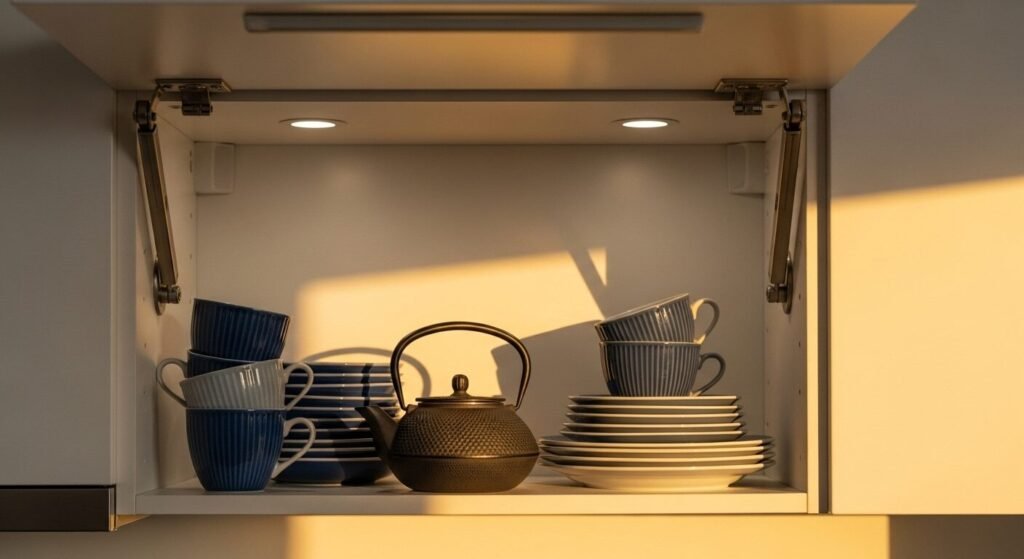
Proper drying and storage of cast iron teaware extends its life and keeps it performing at its best. These steps protect your tetsubin or tetsu kyusu from rust and damage while maintaining its heat retention properties.
Immediate Post-Use Care
- Dry thoroughly after each use with a clean, soft cloth to prevent rust formation.
- Allow air drying completely before storing to eliminate moisture that causes oxidation.
Storage Environment and Methods
- Store in a dry place away from humidity sources like sinks or dishwashers.
- Keep lids slightly ajar during storage to allow air circulation inside the teapot.
- Avoid stacking other items on top of your teaware to prevent chips or cracks in enamel.
- Place a small silica gel packet near stored teaware in very humid climates to absorb excess moisture.
- Store away from direct sunlight which can fade colors of enameled pieces over time.
Ongoing Maintenance
- Apply a thin coat of tea seed oil to unglazed cast iron pieces every few months for extra protection.
- Use regularly rather than leaving unused for months, as regular use helps maintain the seasoning.
- Check stored teaware occasionally for any signs of rust spots that need immediate attention.
Managing Rust
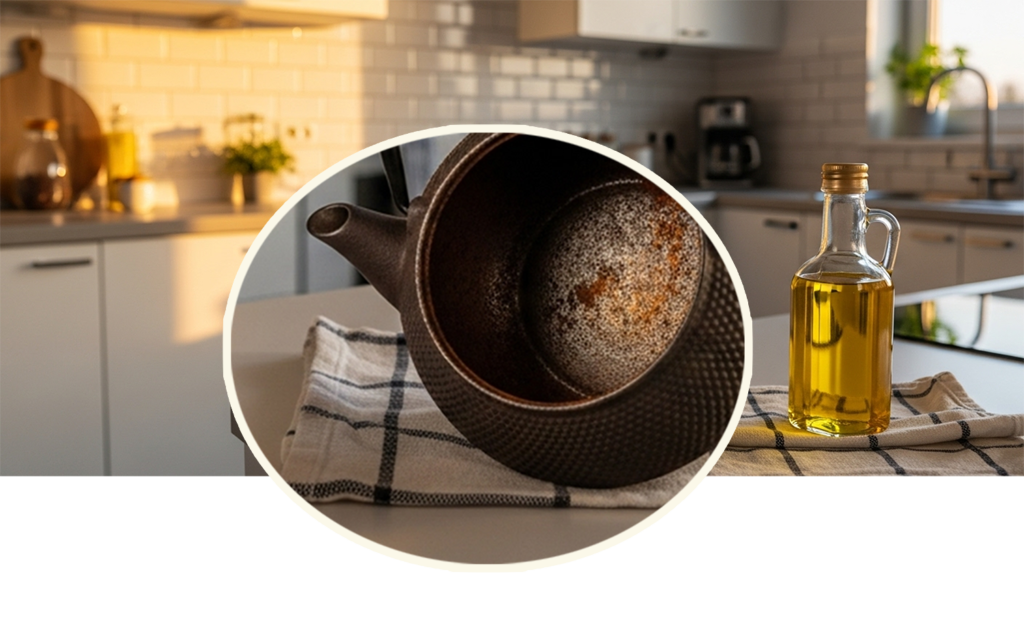
Cast iron teapots will develop rust if not properly maintained. Rust formation doesn’t mean your teapot is ruined – you can restore it with these simple steps.
Initial Use and Seasoning
- For the first use, it is recommended to rinse the kettle with lukewarm or hot water without any detergent or abrasive sponges to protect the interior.
- Some experts suggest an initial seasoning by boiling hard water (high in calcium and magnesium) several times (about 3 times) to form a natural mineral layer called “yuaka” or “hot water scale” inside the kettle, which helps protect against rust
Rust Prevention Methods
- Prevent rust by drying your cast iron teapot thoroughly after each use with a soft cloth.
- Apply a thin coat of vegetable oil to unglazed areas after cleaning to create a protective barrier against moisture.
- Avoid heating the cast iron kettle when empty, as this can cause cracks or damage the iron oxide protective layer inside.
- Store your cast iron teaware with the lid slightly ajar to allow air circulation and prevent moisture buildup.
- Place a silica gel packet near stored teapots in humid climates to absorb excess moisture.
Rust Removal and Treatment
- Remove light rust spots by scrubbing gently with a soft brush and warm water.
- Tackle stubborn rust with a paste made from baking soda and water applied to affected areas.
- Boil water in your rusty tetsubin for 20 minutes to help loosen rust particles from the interior.
- Rinse the teapot several times with clean water after any rust removal treatment.
- Check your teapot regularly for early signs of rust formation, which appear as orange-brown spots.
Conclusion
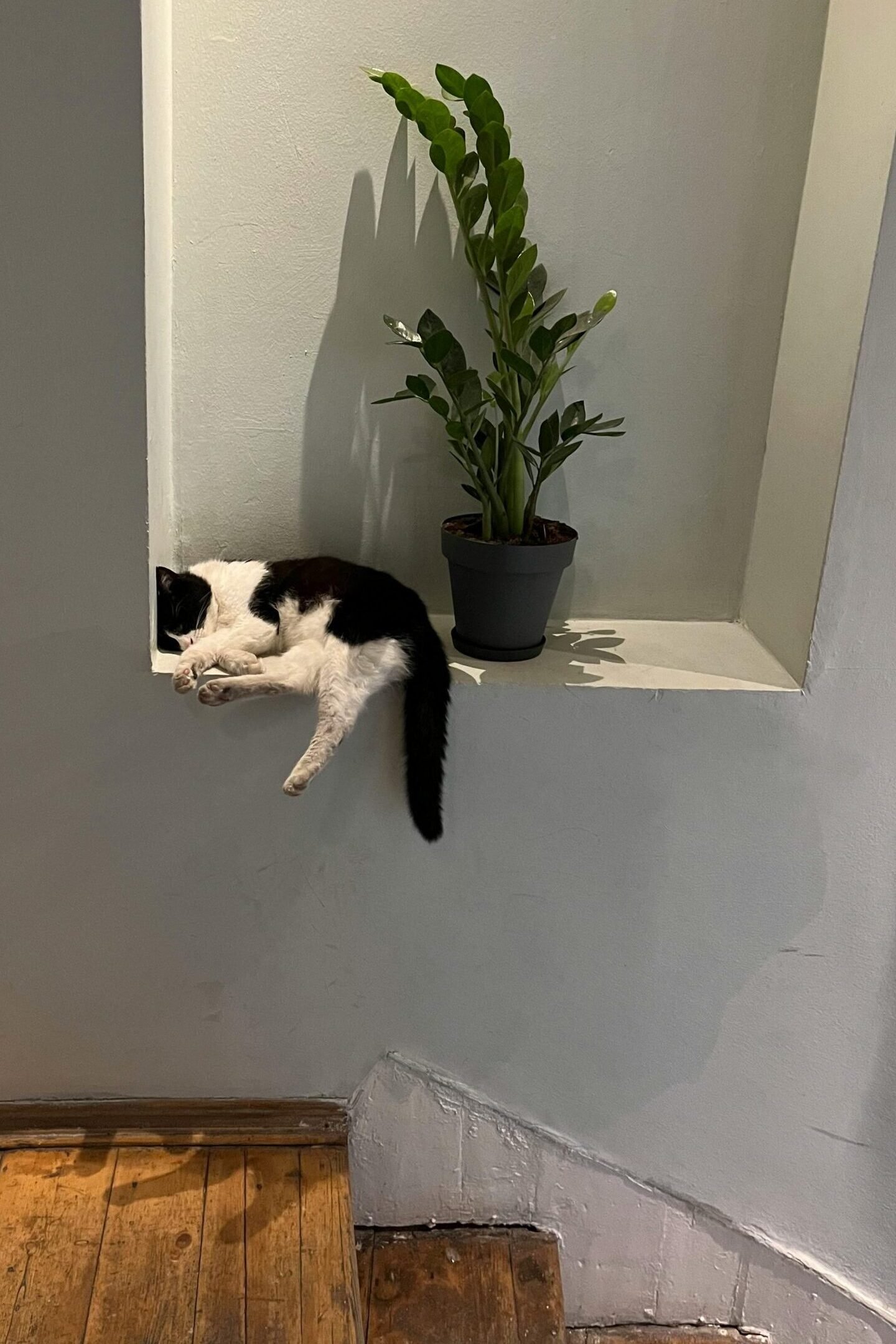
Cast iron teaware offers tea lovers unmatched heat retention and durability. Your tea stays warm longer, letting you savor each sip without rushing. These pots develop character over time, becoming cherished pieces that tell stories of countless brews.
Proper care ensures your teapot will serve you for decades, possibly becoming an heirloom passed through generations. Make the switch to cast iron and experience tea as it was meant to be enjoyed—with patience, warmth, and appreciation for tradition.
For the perfect companion to your cast iron teaware, explore our selection of high-quality tea strainers designed to elevate your tea experience.
FAQs
1. What makes cast iron teaware better than other materials?
Cast iron teaware offers superior heat retention, keeping your tea hot longer than glass or ceramic options. The dense material distributes heat evenly throughout the pot. This consistent temperature helps extract the full flavor from your tea leaves.
2. How do I care for my cast iron teapot?
Rinse your cast iron teapot with hot water after each use. Never use soap as it damages the seasoning. Dry thoroughly to prevent rust.
3. Can I use cast iron teaware on all heat sources?
Yes, cast iron teaware works on all cooking surfaces including gas, electric, and induction stovetops. Many tea enthusiasts prefer heating water in a separate kettle first, then transferring it to the cast iron pot for brewing.
4. Will cast iron change the taste of my tea?
Cast iron can enhance tea flavor through its excellent heat retention properties. Properly seasoned pots develop a natural coating that can subtly improve taste over time. Many tea connoisseurs choose cast iron specifically for this quality enhancement.




